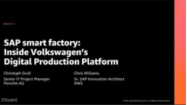SAP Digital Manufacturing Cloud
Filter By
Browse By
- SAP Analytics and AI
- SAP Application Development and Integration
- All SAP Application Development and Integration
- SAP ABAP
- SAP ABAP Development Tools
- SAP ABAP Test Cockpit
- SAP API Management
- SAP BAPI
- SAP Basis
- SAP BRF
- SAP Business Application Studio
- SAP CMS
- SAP Design Studio
- SAP Development Tools
- SAP DevOps
- SAP EAI
- SAP EDI
- SAP Extension Suite
- SAP Fiori
- SAP Fiori Elements
- SAP Integration Suite
- SAP Low Code Application Development
- SAP Low Code Automation
- SAP Netweaver
- SAP Release Management
- SAP UI5
- SAP Web Application Server
- SAP Web IDE
- SAP Business Process Management
- SAP Center of Excellence
- SAP CIO
- SAP Customer Experience
- SAP Data and Data Management
- All SAP Data and Data Management
- SAP BW
- SAP BW/4HANA
- SAP Crystal Reports
- SAP Data Archiving
- SAP Data Center
- SAP Data Governance
- SAP Data Integration
- SAP Data Migration
- SAP Data Quality
- SAP Data Services
- SAP Data Strategy
- SAP Data Visualization
- SAP Data Warehouse Cloud
- SAP DMS
- SAP Document Control
- SAP EIM
- SAP ETL
- SAP ETL Tools
- SAP HANA
- SAP HANA Administration
- SAP HANA Deployment Infrastructure
- SAP HANA Studio
- SAP Master Data
- SAP Master Data Governance
- SAP MDM
- SAP Enterprise Architect
- SAP Enterprise Asset Management
- SAP ERP
- SAP Finance
- All SAP Finance
- SAP Accounting
- SAP AR AP
- SAP Asset Accounting
- SAP Billing Systems
- SAP BPC
- SAP BRIM
- SAP Cash Management
- SAP Central Finance
- SAP Controlling
- SAP COPA
- SAP Cost Center Accounting
- SAP Currency Risk
- SAP e-invoicing
- SAP FICO
- SAP Finance Automation
- SAP Advanced Financial Closing
- SAP Financial Consolidation
- SAP Financial Planning
- SAP FX Risk
- SAP General Ledger
- SAP Global Tax Management
- SAP Hyperion
- SAP Order to Cash
- SAP Payment Processing
- SAP Profitability Analysis
- SAP Rebate Management
- SAP S/4HANA Finance
- SAP SWIFT Compliance
- SAP Treasury Management
- SAP Universal Journal
- SAP Governance Risk and Compliance
- SAP Human Capital Management
- SAP Intelligent Technologies
- SAP Platform and Technology
- All SAP Platform and Technology
- SAP Business Technology Platform
- SAP Cloud
- SAP Cloud Connector
- SAP Cloud Integration Platform
- SAP Cloud Migration
- SAP Cloud Platform
- SAP Cloud Providers
- SAP Cloud Strategy
- SAP Digital Signature
- SAP Container Platform
- SAP HANA Enterprise Cloud
- SAP Digital Asset Management
- SAP Smart Forms
- SAP HEC
- SAP Digital Integration Hub
- SAP Hyperscalers
- SAP Infrastructure
- SAP Messaging
- SAP Quality and Testing
- SAP Security
- SAP Spend Management
- SAP Supply Chain Management
- All SAP Supply Chain Management
- SAP APO
- SAP Asset Management
- SAP Business Network
- SAP Digital Manufacturing Cloud
- SAP Digital Twin
- SAP EWM
- SAP IBP
- SAP Inventory Management
- SAP Label Printing
- SAP Logistics
- SAP Manufacturing
- SAP Manufacturing Automation
- SAP MES
- SAP MII
- SAP MM
- SAP MRO
- SAP MRP
- SAP Order Management
- SAP Plant Maintenance
- SAP PLM
- SAP Production Planning
- SAP S&OP
- SAP SD
- SAP SPM
- SAP Supply Chain Planning
- SAP Track and Trace
- SAP Transportation Management
- SAP System Administration
SAP Supply Chain: Digital Manufacturing Cloud
Market trends are driving changes within manufacturing. It is more important than ever to explore new opportunities with automation and flexible operations for enhanced productivity.
Digital Manufacturing Cloud Defined
Digital manufacturing cloud (DMC) is a cloud-based manufacturing execution system providing a relationship between production and business within supply chain management. It provides the ability to access software from any web browser. DMC optimizes manufacturing performance with integrated production execution, greater visibility, and analysis to meet the high demands of today’s market. By integrating manufacturing and business systems, cost effective and high-quality resources can be used. Some core characteristics are the intuitive user interfaces and modern process-orientated features.
Features include:
- Cloud deployment
- Visibility across the top floor and shop floor
- Key performance indicators and analytics
- Detailed execution of production processes.
Leveraging data helps with performance monitoring. It can detect production-related issues and help trace issues to the root cause, enabling manufacturing operations to be more efficient and scalable. The ability to share information in real time and use advanced analytics to support decision-making is a game changer. It allows traceability, increasing both efficiency and scalability.
SAP Supply Chain: Digital Manufacturing Cloud
Market trends are driving changes within manufacturing. It is more important than ever to explore new opportunities with automation and flexible operations for enhanced productivity.
Digital Manufacturing Cloud Defined
Digital manufacturing cloud (DMC) is a cloud-based manufacturing execution system providing a relationship between production and business within supply chain management. It provides the ability to access software from any web browser. DMC optimizes manufacturing performance with integrated production execution, greater visibility, and analysis to meet the high demands of today’s market. By integrating manufacturing and business systems, cost effective and high-quality resources can be used. Some core characteristics are the intuitive user interfaces and modern process-orientated features.
Features include:
- Cloud deployment
- Visibility across the top floor and shop floor
- Key performance indicators and analytics
- Detailed execution of production processes.
Leveraging data helps with performance monitoring. It can detect production-related issues and help trace issues to the root cause, enabling manufacturing operations to be more efficient and scalable. The ability to share information in real time and use advanced analytics to support decision-making is a game changer. It allows traceability, increasing both efficiency and scalability.
Key capabilities are:
- Harmonized data analytics
- Unified manufacturing modeling
- Integrated manufacturing operations management.
Benefits are:
- Empowered stakeholders to track root causes and enhance manufacturing performance
- Data integration of multiple systems improves visibility and analytics
- Advanced algorithms though machine learning allows root cause analysis for faster insights
- Transparent visibility of production manufacturing to access quality or production issues and reduce risk
- Individualized requirements to improve customer satisfaction
- Optimized use of resources to improve quality and minimize down time.
A solution suite comes with different modules. Organizations can choose the right fit based on their size and industry type. For example, SAP offers DMC for Execution to control the shop floor, while DMC for Insights focuses on performance management and predictive quality across plant locations.
Vendor partners to modernize your digital solution to increase efficiency are: SAP, Accenture, or NTT Data Business Solutions.
Key Considerations for SAPinsiders
- SAP Workloads are Moving to the Cloud. Robert Holland shares his insights on business drivers behind the transformation into the cloud.
- Evolve your Manufacturing Execution System (MES) into a Digital Twin — in the Cloud. Kumar Singh shares this article explaining what a manufacturing execution system is.
- Optimize your Manufacturing Plant by Implementing an MES for Shop Floor Data Collection and Automatic Data Transfer to ECC. Sasa Mitrovic at Summit Global Associates shares insights for common use cases and best practices during implementation.
20 results
-

The EU Battery Passport: Everything you need to know
Reading time: 1 mins
The global battery market is multiplying every year, with an estimated compound annual growth rate of 14% by 2030. While this is a trend affecting multiple sectors, the transition of the transport industry to electric is a major factor in increasing demand for batteries and their key materials. To promote sustainability and circularity, the European…
-

Serialization, Track & Trace for Enhanced Supply Chains
Reading time: 1 mins
Serialization, tracking, and tracing are pivotal in modern supply chains, addressing challenges like regulatory compliance, counterfeit prevention, and product lifecycle visibility. As global regulations evolve, such as the GS1 Standard and the FDA’s DSCSA, businesses must adopt robust digital solutions to ensure safety and efficiency. Aggregation processes capture data hierarchies, improving inventory management and recall…
-

SAP Smart Factory: Inside Volkswagen’s Digital Production Platform
Hear how Volkswagen (VW) created a cloud-native solution with AWS that integrates back-office processes on SAP with its smart factories.
-
-

Bringing Your Digital Factory to Life: Driving Value with SAP Digital Manufacturing
November 14, 2023
Connected machines are only the first step in making the digital factory a reality. To capture real, lasting business value, companies need to collect and analyze process data produced by their plant machinery in real time. Join us for a round table discussion as we uncover the path to transforming your manufacturing processes with SAP…
-

Lessons Learned for Your SAP Digital Manufacturing Cloud (DMC) Journey
April 11, 2023
Changing customer preferences, supply chain disruptions, increased competition, and the pressure to innovate are among the challenges and realities facing today’s manufacturing organizations. If you do not digitize and innovate your manufacturing and production processes, you will be left behind. In this interactive webinar, you will dive into real-world examples of how organizations work with…
-

SAP Digital Manufacturing Cloud
Reading time: 1 min
Integrate business systems to the shop floor and improve the visibility, and analysis for the global operations. Register below and download the One Pager SAP Cloud Manufacturing Solutions provided by Fujitsu.... Membership Required You must be a member to access this content.View Membership LevelsAlready a member? Log in here
-

Responsive Manufacturing: Redefining the Digital Enterprise
Reading time: 6 mins
Customers in the digital age are demanding more: more customization, more control over their purchases, and more guarantees of immediacy. To meet these demands, manufacturers must do more to become flexible and responsive. This means leveraging the Internet of Things (IoT) to enable digital manufacturing processes and gather actionable insights about asset performance. Discover strategies…
-
-

Live from SAPinsider Studio: Mike Lackey on the Evolving Nature of Manufacturing
Mike Lackey, Global VP of Solution Management for LoB Manufacturing at SAP, joins SAPinsider Studio at the SAP SCM 2016 event to discuss how IoT and digital business is transforming the nature of manufacturing. Natalie Miller, SAPinsider: Hi, I’m Natalie Miller with SAPinsider and we’re at the SCM, CRM, and IoT event in Las Vegas...…
-

How SAP S/4HANA Enables Digital Transformation in Supply Chain and Manufacturing
Reading time: 6 mins
The digital transformation is revolutionizing every line of business, and with more products and services available than ever before, the supply chain is a key front for these revolutionary changes. Consumers want their products customized and delivered quickly, which in turn requires supply chains to be agile, fast and flexible. And these capabilities, in turn,…
-

- SAP Digital Manufacturing Cloud
 Premium
Premium
Tips for Mapping Physical Production Operations to the Optimal Manufacturing Type in SAP ECC
Reading time: 16 mins
Management The requirement to integrate your SAP system with a shop floor system can have a profound impact on which manufacturing type you adopt. Learn the characteristics of each manufacturing type in an SAP system and the master data and transactional steps required to implement each in SAP ERP Central Component (ECC). View a decision...…
Become a Member
Unlimited access to thousands of resources for SAP-specific expertise that can only be found here.
Become a Partner
Access exclusive SAP insights, expert marketing strategies, and high-value services including research reports, webinars, and buyers' guides, all designed to boost your campaign ROI by up to 50% within the SAP ecosystem.
Upcoming Events
Related Vendors
Your request has been successfully sent


